由弯矩图画剪力图
- 格式:doc
- 大小:51.00 KB
- 文档页数:2
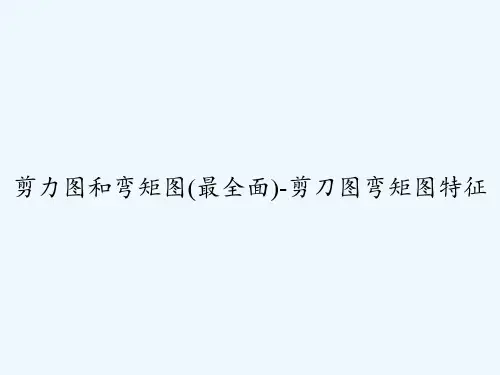
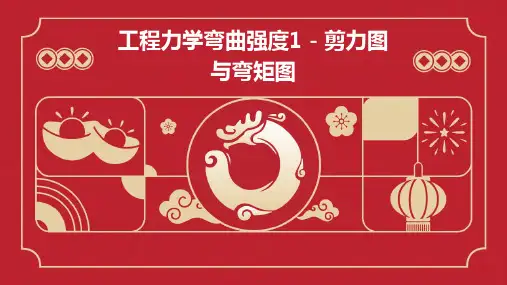
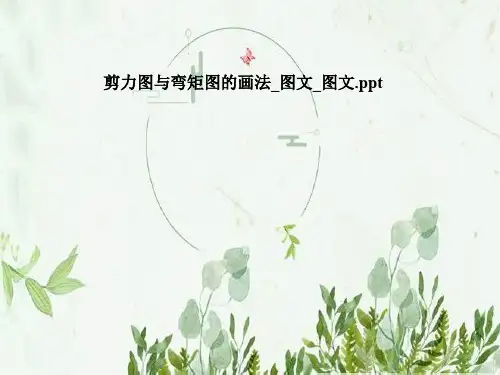
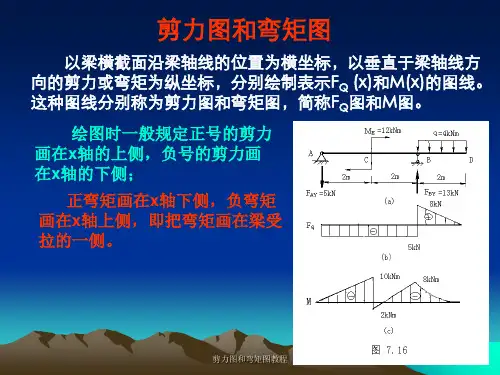
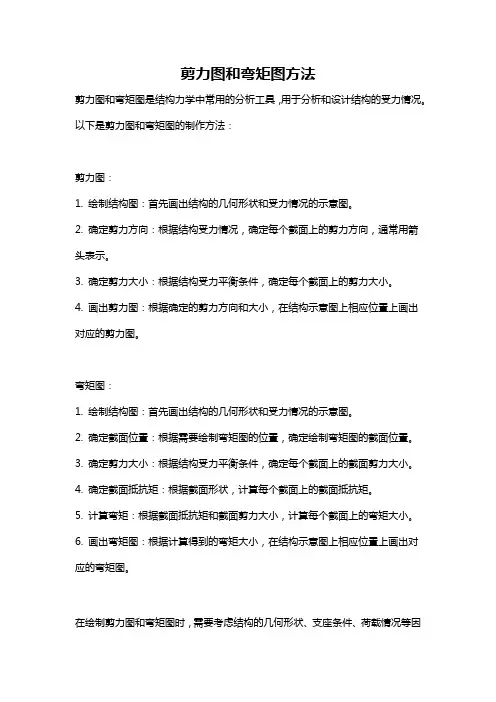
剪力图和弯矩图方法
剪力图和弯矩图是结构力学中常用的分析工具,用于分析和设计结构的受力情况。
以下是剪力图和弯矩图的制作方法:
剪力图:
1. 绘制结构图:首先画出结构的几何形状和受力情况的示意图。
2. 确定剪力方向:根据结构受力情况,确定每个截面上的剪力方向,通常用箭头表示。
3. 确定剪力大小:根据结构受力平衡条件,确定每个截面上的剪力大小。
4. 画出剪力图:根据确定的剪力方向和大小,在结构示意图上相应位置上画出对应的剪力图。
弯矩图:
1. 绘制结构图:首先画出结构的几何形状和受力情况的示意图。
2. 确定截面位置:根据需要绘制弯矩图的位置,确定绘制弯矩图的截面位置。
3. 确定剪力大小:根据结构受力平衡条件,确定每个截面上的截面剪力大小。
4. 确定截面抵抗矩:根据截面形状,计算每个截面上的截面抵抗矩。
5. 计算弯矩:根据截面抵抗矩和截面剪力大小,计算每个截面上的弯矩大小。
6. 画出弯矩图:根据计算得到的弯矩大小,在结构示意图上相应位置上画出对应的弯矩图。
在绘制剪力图和弯矩图时,需要考虑结构的几何形状、支座条件、荷载情况等因
素,同时应满足受力平衡条件和连续性要求。
这些图形分析的结果可以帮助工程师评估结构的受力情况,进行结构设计和优化。
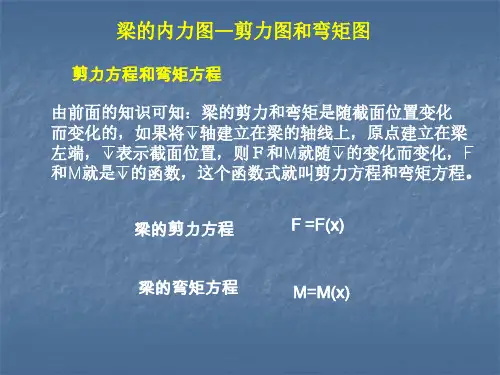
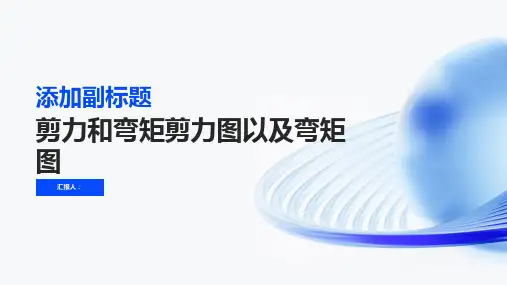
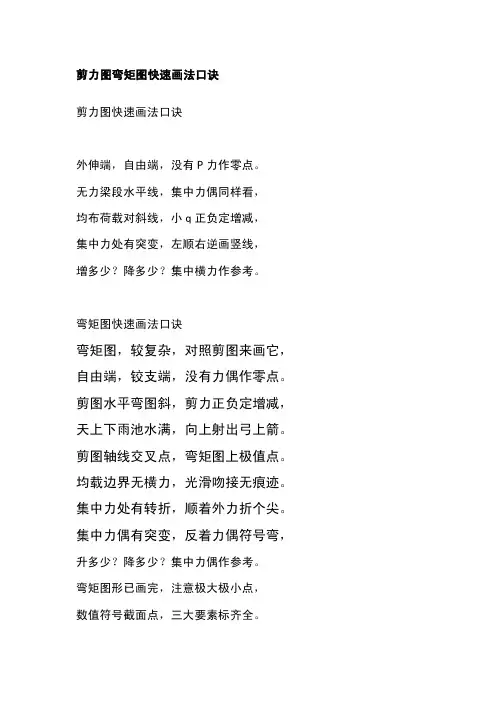
剪力图弯矩图快速画法口诀剪力图快速画法口诀外伸端,自由端,没有P力作零点。
无力梁段水平线,集中力偶同样看,均布荷载对斜线,小q正负定增减,集中力处有突变,左顺右逆画竖线,增多少?降多少?集中横力作参考。
弯矩图快速画法口诀弯矩图,较复杂,对照剪图来画它,自由端,铰支端,没有力偶作零点。
剪图水平弯图斜,剪力正负定增减,天上下雨池水满,向上射出弓上箭。
剪图轴线交叉点,弯矩图上极值点。
均载边界无横力,光滑吻接无痕迹。
集中力处有转折,顺着外力折个尖。
集中力偶有突变,反着力偶符号弯,升多少?降多少?集中力偶作参考。
弯矩图形已画完,注意极大极小点,数值符号截面点,三大要素标齐全。
7.2.1 截面法求内力问题:梁在发生平面弯曲变形时,横截面上会产生何种内力素?在横截面上会有几种内力素同时存在?如何求出这些内力素?例:欲求图示简支梁任意截面1-1上的内力。
1.截开:在1-1截面处将梁截分为左、右两部分,取左半部分为研究对象。
2.代替:在左半段的1-1截面处添画内力、,(由平衡解释)代替右半部分对其作用。
3.平衡:整个梁是平衡的,截开后的每一部分也应平衡。
由得如取右半段为研究对象,同样可以求得截面1-1上的内力和,但左、右半段求得的及数值相等,方向(或转向)相反。
7.2.2 剪力和弯矩是横截面上法向分布内力分量的合力偶矩,因在纵向对称面内且与截面垂直,故称为截面1-1的弯矩。
由于取左半段与取右半段所得剪力和弯矩的方向(或转向)相反,为使无论取左半段或取右半段所得剪力和弯矩的正负符号相同,必须对剪力和弯矩的正负符号做适当规定。
剪力的正负:使微段梁产生左侧截面向上、右侧截面向下的剪力为正,反之为负。
弯矩的正负:使微段梁产生上凹下凸弯曲变形的弯矩为正,反之为负。
归纳剪力和弯矩的计算公式:(截面上的弯矩等于截面一侧所有外力对截面形心取力矩的代数和。
)公式中外力和外力矩的正负规定:剪力公式中外力的正负规定:截面左段梁上向上作用的横向外力或右段梁上向下作用的横向外力在该截面上产生的剪力为正,反之为负。
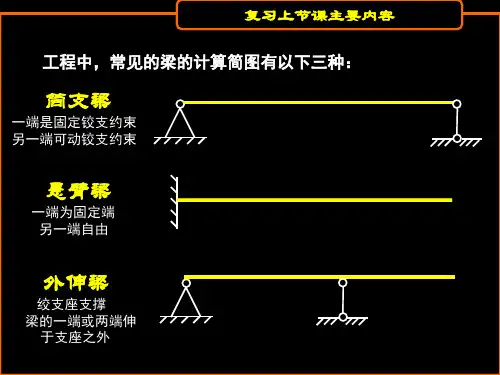

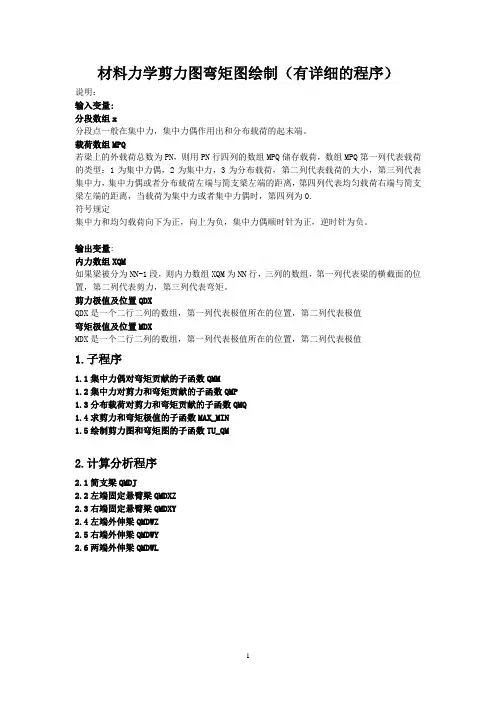
材料力学剪力图弯矩图绘制(有详细的程序)说明:输入变量:分段数组x分段点一般在集中力,集中力偶作用出和分布载荷的起末端。
载荷数组MPQ若梁上的外载荷总数为PN,则用PN行四列的数组MPQ储存载荷,数组MPQ第一列代表载荷的类型:1为集中力偶,2为集中力,3为分布载荷,第二列代表载荷的大小,第三列代表集中力,集中力偶或者分布载荷左端与简支梁左端的距离,第四列代表均匀载荷右端与简支梁左端的距离,当载荷为集中力或者集中力偶时,第四列为0.符号规定集中力和均匀载荷向下为正,向上为负,集中力偶顺时针为正,逆时针为负。
输出变量:内力数组XQM如果梁被分为NN-1段,则内力数组XQM为NN行,三列的数组,第一列代表梁的横截面的位置,第二列代表剪力,第三列代表弯矩。
剪力极值及位置QDXQDX是一个二行二列的数组,第一列代表极值所在的位置,第二列代表极值弯矩极值及位置MDXMDX是一个二行二列的数组,第一列代表极值所在的位置,第二列代表极值1.子程序1.1集中力偶对弯矩贡献的子函数QMM1.2集中力对剪力和弯矩贡献的子函数QMP1.3分布载荷对剪力和弯矩贡献的子函数QMQ1.4求剪力和弯矩极值的子函数MAX_MIN1.5绘制剪力图和弯矩图的子函数TU_QM2.计算分析程序2.1简支梁QMDJ2.2左端固定悬臂梁QMDXZ2.3右端固定悬臂梁QMDXY2.4左端外伸梁QMDWZ2.5右端外伸梁QMDWY2.6两端外伸梁QMDWL1.子程序1.1集中力偶对弯矩贡献的子函数QMMfunction MM=QMM(n,x1,a,M,MM)for j=1:nif x1(j)==an1=j;endendMM(n1:n)=MM(n1:n)+M;1.2集中力对剪力和弯矩贡献的子函数QMP function [QQ,MM]=QMP(n,x1,b,P,QQ,MM)for j=1:nif x1(j)==b;n1=j;endendQQ(n1:n)=QQ(n1:n)-P;MM(n1:n)=MM(n1:n)-P*(x1(n1:n)-b);1.3分布载荷对剪力和弯矩贡献的子函数QMQ function [QQ,MM]=QMQ(n,x1,c,d,q,QQ,MM)for j=1:nif x1(j)>cQQ(j)=QQ(j)-q*(x1(j)-c);MM(j)=MM(j)-0.5*q*(x1(j)-c)^2;endif x1(j)>dQQ(j)=QQ(j)+q*(x1(j)-d);MM(j)=MM(j)+0.5*q*(x1(j)-d)^2;endend1.4求剪力和弯矩极值的子函数MAX_MINfunction [QDX,MDX,XQM]=MAX_MIN(x1,QQ,MM) XQM=[x1',QQ',MM'];[Qmax,i]=max(QQ);Q1=[Qmax,x1(i)];[Qmin,i]=min(QQ);Q2=[Qmin,x1(i)];[Mmax,i]=max(MM);M1=[Mmax,x1(i)];[Mmin,i]=min(MM);M2=[Mmin,x1(i)];disp('剪力极值及位置')QDX=[Q1;Q2]disp('弯矩极值及位置')MDX=[M1;M2]t1=findobj(0,'Tag','text31');str=num2str(Q1(1));set(t1,'String',str);t2=findobj(0,'Tag','text39');str=num2str(Q1(2));set(t2,'String',str);t3=findobj(0,'Tag','text32');str=num2str(Q2(1));set(t3,'String',str);t4=findobj(0,'Tag','text40');str=num2str(Q2(2));set(t4,'String',str);m1=findobj(0,'Tag','text33');str=num2str(M1(1));set(m1,'String',str);m2=findobj(0,'Tag','text41');str=num2str(M1(2));set(m2,'String',str);m3=findobj(0,'Tag','text34');str=num2str(M2(1));set(m3,'String',str);m4=findobj(0,'Tag','text42');str=num2str(M2(2));set(m4,'String',str);1.5绘制剪力图和弯矩图的子函数TU_QM function TU_QM(x1,QQ,MM)h1=findobj(0,'Tag','axes1');axes(h1);plot(x1,QQ);grid;title('剪力图');h2=findobj(0,'Tag','axes2');axes(h2);plot(x1,MM);grid;title('弯矩图');2.计算分析程序2.1简支梁QMDJfunction XQM=QMDJ(x,MPQ)[n,m]=size(x);L=x(m);x1=[];for i=1:m-1x1=[x1,linspace(x(i),x(i+1),50)];endMM=zeros(size(x1));QQ=zeros(size(x1));[m,t]=size(MPQ);[t,n]=size(x1);for i=1:mswitch MPQ(i,1)case 1M=MPQ(i,2);a=MPQ(i,3);RA=-M/L;QQ=QQ+RA;MM=MM+RA*x1;if a>0 & a<LMM=QMM(n,x1,a,M,MM);endif a==0MM=MM+M;endcase 2P=MPQ(i,2);b=MPQ(i,3);RA=(L-b)*P/L;if b>0 & b<LQQ=QQ+RA;MM=MM+RA*x1;[QQ,MM]=QMP(n,x1,b,P,QQ,MM);endcase 3q=MPQ(i,2);c=MPQ(i,3);d=MPQ(i,4);RA=(L-0.5*(c+d))*q*(d-c)/L;QQ=QQ+RA;MM=MM+RA*x1+MA;[QQ,MM]=QMQ(n,x1,c,d,q,QQ,MM);endend[QDX,MDX,XQM]=MAX_MIN(x1,QQ,MM);TU_QM(x1,QQ,MM);disp('梁的有限元分析结果')disp('位置-----------剪力----------弯矩')2.2左端固定悬臂梁QMDXZfunction XQM=QMDXZ(x,MPQ)[n,m]=size(x);L=x(m);x1=[];for i=1:m-1x1=[x1,linspace(x(i),x(i+1),50)];endMM=zeros(size(x1));QQ=zeros(size(x1));[PN,t]=size(MPQ);[t,n]=size(x1);for i=1:PNswitch MPQ(i,1)case 1M=MPQ(i,2);a=MPQ(i,3);if a>0 & a<LMM=MM-M;MM=QMM(n,x1,a,M,MM);endif a==LMM=MM-M;endcase 2P=MPQ(i,2);b=MPQ(i,3);RA=P;MA=-P*b;QQ=QQ+RA;MM=MM+RA*x1+MA;if b>0 & b<L[QQ,MM]=QMP(n,x1,b,P,QQ,MM);endcase 3q=MPQ(i,2);c=MPQ(i,3);d=MPQ(i,4);RA=q*(d-c);MA=-0.5*q*(d-c)*(d+c);QQ=QQ+RA;MM=MM+RA*x1+MA;[QQ,MM]=QMQ(n,x1,c,d,q,QQ,MM);endend[QDX,MDX,XQM]=MAX_MIN(x1,QQ,MM);TU_QM(x1,QQ,MM);disp('梁的有限元分析结果')disp('位置-----------剪力----------弯矩')2.3右端固定悬臂梁QMDXYfunction XQM=QMDXY(x,MPQ)[n,m]=size(x);L=x(m);x1=[];for i=1:m-1x1=[x1,linspace(x(i),x(i+1),50)];endMM=zeros(size(x1));QQ=zeros(size(x1));[PN,t]=size(MPQ);[t,n]=size(x1);for i=1:PNswitch MPQ(i,1)case 1M=MPQ(i,2);a=MPQ(i,3);if a==0MM=MM+M;endif a>0 & a<LMM=QMM(n,x1,a,M,MM);endcase 2P=MPQ(i,2);b=MPQ(i,3);if b==0QQ=QQ-PMM=MM-P*x1;endif b>0 & b<L[QQ,MM]=QMP(n,x1,b,P,QQ,MM);endcase 3q=MPQ(i,2);c=MPQ(i,3);d=MPQ(i,4);[QQ,MM]=QMQ(n,x1,c,d,q,QQ,MM);endend[QDX,MDX,XQM]=MAX_MIN(x1,QQ,MM);TU_QM(x1,QQ,MM);disp('梁的有限元分析结果')disp('位置-----------剪力----------弯矩')2.4左端外伸梁QMDWZfunction XQM=QMDWZ(x,L1,MPQ)[n,m]=size(x);L=x(m);x1=[];for i=1:m-1x1=[x1,linspace(x(i),x(i+1),50)];endMM=zeros(size(x1));QQ=zeros(size(x1));[PN,t]=size(MPQ);[t,n]=size(x1);for i=1:PNswitch MPQ(i,1)case 1M=MPQ(i,2);a=MPQ(i,3);if a>0 & a<LMM=QMM(n,x1,a,M,MM);endif a==0MM=MM+M;endcase 2P=MPQ(i,2);b=MPQ(i,3);RA=P*(L-b)/(L-L1);[QQ,MM]=QMP(n,x1,L1,-RA,QQ,MM);if b>0 & b<L[QQ,MM]=QMP(n,x1,b,P,QQ,MM);endif b==0QQ=QQ-P;MM=MM-P*x1;endcase 3q=MPQ(i,2);c=MPQ(i,3);d=MPQ(i,4);b=(c+d)*0.5;P=(d-c)*q;RA=P*(L-b)/(L-L1);[QQ,MM]=QMP(n,x1,L1,-RA,QQ,MM);[QQ,MM]=QMQ(n,x1,c,d,q,QQ,MM);endend[QDX,MDX,XQM]=MAX_MIN(x1,QQ,MM);TU_QM(x1,QQ,MM);disp('梁的有限元分析结果')disp('位置-----------剪力----------弯矩')2.5右端外伸梁QMDWYfunction XQM=QMDWY(x,L1,MPQ)[n,m]=size(x);L=x(m);x1=[];for i=1:m-1x1=[x1,linspace(x(i),x(i+1),50)];endMM=zeros(size(x1));QQ=zeros(size(x1));[PN,t]=size(MPQ);[t,n]=size(x1);for i=1:PNswitch MPQ(i,1)case 1M=MPQ(i,2);a=MPQ(i,3);RA=-M/L1;RB=-RA;QQ=QQ+RA;MM=MM+x1*RA;if a>0 & a<LMM=QMM(n,x1,a,M,MM);endif a==0MM=MM+M;endcase 2P=MPQ(i,2);b=MPQ(i,3);RA=P*(L1-b)/L1;RB=P*b/L1;QQ=QQ+RA;MM=MM+x1*RA;[QQ,MM]=QMP(n,x1,L1,-RB,QQ,MM);if b>0 & b<L[QQ,MM]=QMP(n,x1,b,P,QQ,MM);endif b==0QQ=QQ-P;MM=MM-P*x1;endcase 3q=MPQ(i,2);c=MPQ(i,3);d=MPQ(i,4);b=(c+d)*0.5;P=(d-c)*q;RA=P*(L1-b)/L1;RB=P*b/L1;QQ=QQ+RA;MM=MM+x1*RA;[QQ,MM]=QMP(n,x1,L1,-RB,QQ,MM);[QQ,MM]=QMQ(n,x1,c,d,q,QQ,MM);endend[QDX,MDX,XQM]=MAX_MIN(x1,QQ,MM);TU_QM(x1,QQ,MM);disp('梁的有限元分析结果')disp('位置-----------剪力----------弯矩')2.6两端外伸梁QMDWLfunction XQM=QMDWL(x,L1,L2,MPQ)[n,m]=size(x);L=x(m);x1=[];for i=1:m-1x1=[x1,linspace(x(i),x(i+1),50)];endMM=zeros(size(x1));QQ=zeros(size(x1));[PN,t]=size(MPQ);[t,n]=size(x1);for i=1:PNswitch MPQ(i,1)case 1M=MPQ(i,2);a=MPQ(i,3);RA=-M/(L2-L1);RB=-RA;if a>0 & a<LMM=QMM(n,x1,a,M,MM);endif a==0MM=MM+M;endcase 2P=MPQ(i,2);b=MPQ(i,3);LL=L2-L1;bb=b-L1;RA=P*(LL-bb)/LL;RB=P*bb/LL;[QQ,MM]=QMP(n,x1,L1,-RA,QQ,MM);[QQ,MM]=QMP(n,x1,L2,-RB,QQ,MM);if b>0 & b<L[QQ,MM]=QMP(n,x1,b,P,QQ,MM);endif b==0QQ=QQ-P;MM=MM-P*x1;endcase 3q=MPQ(i,2);c=MPQ(i,3);d=MPQ(i,4);b=(c+d)*0.5;P=(d-c)*q;LL=L2-L1;bb=b-L1;RA=P*(LL-bb)/LL;RB=P*bb/LL;[QQ,MM]=QMP(n,x1,L1,-RA,QQ,MM);[QQ,MM]=QMP(n,x1,L2,-RB,QQ,MM);[QQ,MM]=QMQ(n,x1,c,d,q,QQ,MM);endend[QDX,MDX,XQM]=MAX_MIN(x1,QQ,MM);TU_QM(x1,QQ,MM);disp('梁的有限元分析结果')disp('位置-----------剪力----------弯矩')untitled.mfunction varargout = untitled(varargin)% UNTITLED M-file for untitled.fig% UNTITLED, by itself, creates a new UNTITLED or raises the existing% singleton*.%% H = UNTITLED returns the handle to a new UNTITLED or the handle to% the existing singleton*.%% UNTITLED('CALLBACK',hObject,eventData,handles,...) calls the local% function named CALLBACK in UNTITLED.M with the given input arguments. %% UNTITLED('Property','Value',...) creates a new UNTITLED or raises the% existing singleton*. Starting from the left, property value pairs are% applied to the GUI before untitled_OpeningFunction gets called. An% unrecognized property name or invalid value makes property application% stop. All inputs are passed to untitled_OpeningFcn via varargin.%% *See GUI Options on GUIDE's Tools menu. Choose "GUI allows only one% instance to run (singleton)".%% See also: GUIDE, GUIDA TA, GUIHANDLES% Edit the above text to modify the response to help untitled% Last Modified by GUIDE v2.5 03-Jun-2008 23:12:06% Begin initialization code - DO NOT EDITgui_Singleton = 1;gui_State = struct('gui_Name', mfilename, ...'gui_Singleton', gui_Singleton, ...'gui_OpeningFcn', @untitled_OpeningFcn, ...'gui_OutputFcn', @untitled_OutputFcn, ...'gui_LayoutFcn', [] , ...'gui_Callback', []);if nargin && ischar(varargin{1})gui_State.gui_Callback = str2func(varargin{1});endif nargout[varargout{1:nargout}] = gui_mainfcn(gui_State, varargin{:}); elsegui_mainfcn(gui_State, varargin{:});end% End initialization code - DO NOT EDIT% --- Executes just before untitled is made visible.function untitled_OpeningFcn(hObject, eventdata, handles, varargin) % This function has no output args, see OutputFcn.% hObject handle to figure% eventdata reserved - to be defined in a future version of MATLAB % handles structure with handles and user data (see GUIDA TA) % varargin command line arguments to untitled (see V ARARGIN)% Choose default command line output for untitledhandles.output = hObject;% Update handles structureguidata(hObject, handles);% UIWAIT makes untitled wait for user response (see UIRESUME) % uiwait(handles.figure1);% --- Outputs from this function are returned to the command line. function varargout = untitled_OutputFcn(hObject, eventdata, handles) % varargout cell array for returning output args (see V ARARGOUT); % hObject handle to figure% eventdata reserved - to be defined in a future version of MATLAB % handles structure with handles and user data (see GUIDA TA)% Get default command line output from handles structure varargout{1} = handles.output;function edit2_Callback(hObject, eventdata, handles)% hObject handle to edit2 (see GCBO)% eventdata reserved - to be defined in a future version of MATLAB% handles structure with handles and user data (see GUIDA TA)% Hints: get(hObject,'String') returns contents of edit2 as text% str2double(get(hObject,'String')) returns contents of edit2 as a double% --- Executes during object creation, after setting all properties.function edit2_CreateFcn(hObject, eventdata, handles)% hObject handle to edit2 (see GCBO)% eventdata reserved - to be defined in a future version of MATLAB% handles empty - handles not created until after all CreateFcns called% Hint: edit controls usually have a white background on Windows.% See ISPC and COMPUTER.if ispc && isequal(get(hObject,'BackgroundColor'), get(0,'defaultUicontrolBackgroundColor')) set(hObject,'BackgroundColor','white');endfunction edit3_Callback(hObject, eventdata, handles)% hObject handle to edit3 (see GCBO)% eventdata reserved - to be defined in a future version of MATLAB% handles structure with handles and user data (see GUIDA TA)% Hints: get(hObject,'String') returns contents of edit3 as text% str2double(get(hObject,'String')) returns contents of edit3 as a double% --- Executes during object creation, after setting all properties.function edit3_CreateFcn(hObject, eventdata, handles)% hObject handle to edit3 (see GCBO)% eventdata reserved - to be defined in a future version of MATLAB% handles empty - handles not created until after all CreateFcns called% Hint: edit controls usually have a white background on Windows.% See ISPC and COMPUTER.if ispc && isequal(get(hObject,'BackgroundColor'), get(0,'defaultUicontrolBackgroundColor')) set(hObject,'BackgroundColor','white');endfunction edit4_Callback(hObject, eventdata, handles)% hObject handle to edit4 (see GCBO)% eventdata reserved - to be defined in a future version of MATLAB% handles structure with handles and user data (see GUIDA TA)% Hints: get(hObject,'String') returns contents of edit4 as text% str2double(get(hObject,'String')) returns contents of edit4 as a double% --- Executes during object creation, after setting all properties.function edit4_CreateFcn(hObject, eventdata, handles)% hObject handle to edit4 (see GCBO)% eventdata reserved - to be defined in a future version of MATLAB% handles empty - handles not created until after all CreateFcns called% Hint: edit controls usually have a white background on Windows.% See ISPC and COMPUTER.if ispc && isequal(get(hObject,'BackgroundColor'), get(0,'defaultUicontrolBackgroundColor')) set(hObject,'BackgroundColor','white');end% --- Executes on selection change in popupmenu1.function popupmenu1_Callback(hObject, eventdata, handles)% hObject handle to popupmenu1 (see GCBO)% eventdata reserved - to be defined in a future version of MATLAB% handles structure with handles and user data (see GUIDATA)% Hints: contents = get(hObject,'String') returns popupmenu1 contents as cell array% contents{get(hObject,'Value')} returns selected item from popupmenu1% --- Executes during object creation, after setting all properties.function popupmenu1_CreateFcn(hObject, eventdata, handles)% hObject handle to popupmenu1 (see GCBO)% eventdata reserved - to be defined in a future version of MATLAB% handles empty - handles not created until after all CreateFcns called% Hint: popupmenu controls usually have a white background on Windows.% See ISPC and COMPUTER.if ispc && isequal(get(hObject,'BackgroundColor'), get(0,'defaultUicontrolBackgroundColor')) set(hObject,'BackgroundColor','white');end% --- Executes on button press in pushbutton3.function pushbutton3_Callback(hObject, eventdata, handles)% hObject handle to pushbutton3 (see GCBO)% eventdata reserved - to be defined in a future version of MATLAB% handles structure with handles and user data (see GUIDA TA)x=str2num(get(handles.edit2,'string'));MPQ=str2num(get(handles.edit3,'string'));L=str2num(get(handles.edit4,'string'));L1=L(1);L2=L(2);val=get(handles.popupmenu1,'Value');str=get(handles.popupmenu1,'String');switch str{val}case '简支梁'QMDJ(x,MPQ)case '左端固定悬臂梁'QMDXZ(x,MPQ)case '右端固定悬臂梁'QMDXY(x,MPQ)case '左端外伸梁'QMDWZ(x,L1,MPQ)case '右端外伸梁'QMDWY(x,L1,MPQ)case '两端外伸梁'QMDWL(x,L1,L2,MPQ)end% --- Executes on button press in pushbutton4.function pushbutton4_Callback(hObject, eventdata, handles)% hObject handle to pushbutton4 (see GCBO)% eventdata reserved - to be defined in a future version of MATLAB % handles structure with handles and user data (see GUIDATA) close all% --- Executes on key press over popupmenu1 with no controls selected. function popupmenu1_KeyPressFcn(hObject, eventdata, handles)% hObject handle to popupmenu1 (see GCBO)% eventdata reserved - to be defined in a future version of MATLAB % handles structure with handles and user data (see GUIDA TA)。
1.1.4 根据弯矩图作剪力图
1.1.4 根据弯矩图作剪力图
利用微分关系,可方便地根据弯矩图作剪力图。
(一)当M图为直线变化时
以图1-4a所示跨中作用集中荷载的简支梁为例,加以说明。
其M图和图分别示于图1-4b和图1-4c。
图1-4
在图1-4b中,循惯例,选取直角坐标系。
当我们分区段考察M图形与图形的关系时,若沿轴的指向,由左向右看,则将会看到如下客观规律:
第一,关于的符号:AC段,M“下坡”(M为增函数),则其相应的为正(M的一阶导数>0);CB段,M“上坡”(M为减函数),则其相应的为负(M的一阶导数<0)。
第二,关于的大小:可由M图形的“坡度”(斜率)确定,即,其中,为该区段长度,为图中该区段两端点弯矩值的高差。
而且,区段内图形“坡度”愈徒,剪力值愈大;
“坡度”愈缓,剪力值愈小;“坡度”为零(M图为水平直线),则剪力值亦为零(无剪力)。
二相邻区段的M图形“坡度”相同(当有集有力偶作用时),则其剪力值亦相同。
例如,本例中,AC段的剪力为
而CB段的剪力为
这一规律同样适用于竖杆或斜杆,只是须注意应沿杆轴“由左向右看”这一前提条件。
(二)当M图为二次抛物线变化时
根据M与的微分关系可判定,该图为斜直线。
因此,只须按照“一求两端剪力,二引直线相
连”的步骤,即可绘出该区段的图。
图1-5是根据已知弯矩图(图1-5a)绘出相应剪力轮廊图(图1-5b)的一个例子。
图1-5。